Artificial intelligence and chatbots are having a major media moment. After the 2022 release of ChatGPT by Open AI, more people are benefiting from accessible and practical applications of AI. In interacting with tools like ChatGPT or customer service chatbots, they use conversational user interfaces.
Conversational interfaces play a pivotal role in shaping the user experience and functionality of modern applications. These interfaces leverage natural language processing (NLP) and artificial intelligence (AI) to enable users to interact with applications using spoken or written language.
In the dynamic landscape of conversational interfaces, Amazon Lex stands out as a powerful tool for building chatbots and interactive voice response systems. This comprehensive guide aims to demystify Amazon Lex, exploring its features, use cases, and the steps involved in creating sophisticated conversational experiences.
Technical Aspects
Natural Language Processing (NLP) in Amazon Lex
Amazon Lex is a natural language processing (NLP) provider from AWS that powers conversational AI solutions for voice and chat. It uses NLP to understand spoken instructions and user intent, and automatic speech recognition (ASR) to convert spoken language into text.
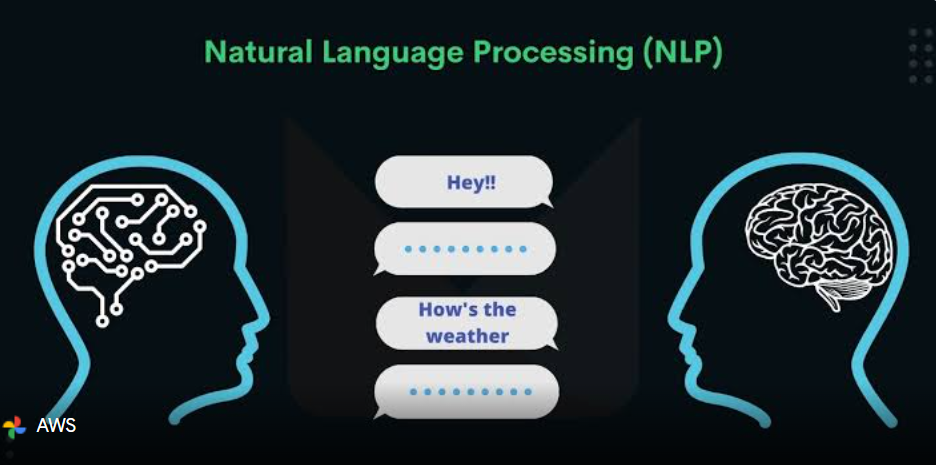
NLU allows the system to understand the meaning and intent behind user input. The combination of NLU and ASR enables Amazon Lex to accurately understand and respond to user input, regardless of whether it is spoken or typed.
Amazon Lex is a flexible chatbot framework that uses NLP and Machine Learning capabilities. It enables developers to build chatbots using conversational AI in applications.
Intent, Slot, Utterance and Fulfillment in Amazon Lex
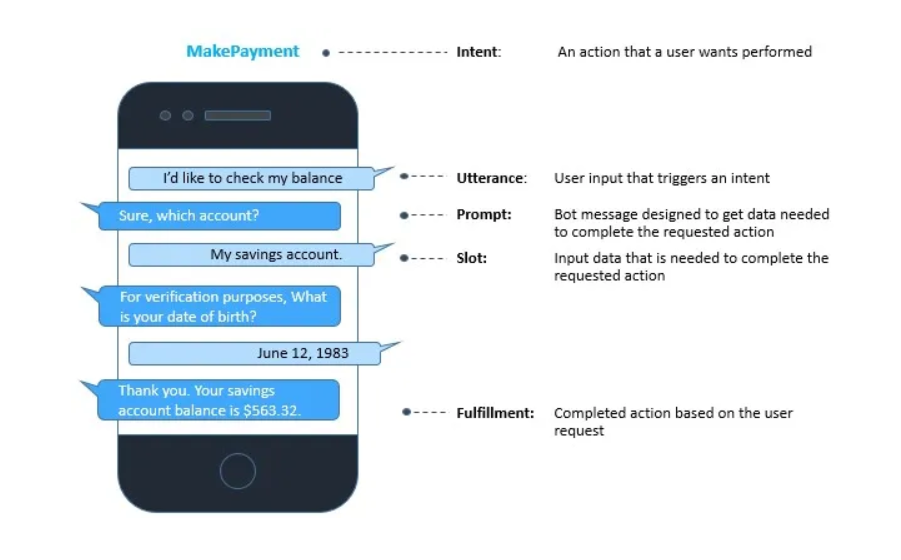
Intent
An intent represents the goal or purpose of a user’s input. It defines the action the application should take when a user expresses a particular intention.
Slot
A slot is a variable representing a piece of information the application needs to fulfill the user’s intent. Slots help extract specific details from the user’s input.
Utterance
An utterance is a sample phrase or sentence that a user might say to convey a particular intent. Utterances are used to train the natural language processing (NLP) model.
Fulfillment
Fulfillment in Amazon Lex is a critical step in building functional and interactive conversational interfaces. It enables developers to create bots that not only understand user input but also take meaningful actions, making the overall conversational experience more valuable and productive. By leveraging AWS Lambda functions and integrating with external services, developers can tailor the fulfillment process to meet specific application requirements.
Integration with Other AWS Services
AWS Lambda Integration
- Overview:
AWS Lambda allows developers to run code without provisioning or managing servers. Integration with Lambda enables the execution of custom logic in response to user intents identified by Amazon Lex.
- How it Works:
Developers associate an AWS Lambda function with an intent in Amazon Lex.
When a user triggers the associated intent, the specified Lambda function is invoked.
Lambda functions can perform tasks such as database queries, business logic execution, or external API calls.
Amazon DynamoDB Integration
- Overview:
Amazon DynamoDB is a fully managed NoSQL database service. Integrating Amazon Lex with DynamoDB allows developers to store and retrieve structured data, enhancing the bot’s ability to manage user-specific information or application state.
- How it Works:
Developers configure the Amazon Lex bot to interact with specific DynamoDB tables. DynamoDB can be used to store persistent data related to user profiles, preferences, or any information needed for a more personalized user experience.
The bot can query DynamoDB to retrieve relevant data during
conversations, enabling dynamic and data-driven interactions.
Multi-Turn Conversations and Session Management
Multi-turn conversations refer to interactions between a user and a conversational interface that extend over several exchanges or turns. In a multi-turn conversation, the system processes user input, provides a response, and the dialogue continues based on the context of the conversation.
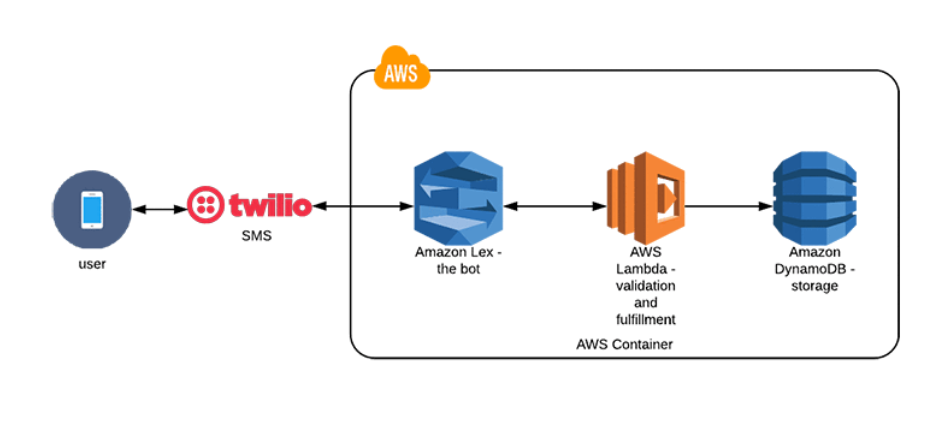
Code Snippets
Building Chatbots with Amazon Lex of HotelBookingBot
Embarking on the journey of creating a chatbot with Amazon Lex involves several key steps of HotelBookingBot.
Step 1: Setting Up Your Hotel Booking Lex Bot
Begin by creating a new Lex bot in the AWS Management Console. Define the bot’s name, language.
Here bot name is HotelBookingBot.

Define the Bot Language is English.

Step 2: Defining Intents and Utterances
Intents represent the goals that users can achieve with the chatbot. Define intents and associated sample utterances to train the model to recognize user input.
Here Intent Name is BookHotel.

Define some Utterances.

Step 3: Configuring Slots for Entity Recognition
Slots are placeholders for information that users provide. Configure slots to extract entities and gather necessary information during conversations.
Here Configure the slots with Build-in slot type and one Custom slot type.

For Custom slot type create a custom slot that is RoomType.

Step 4: Fulfillment Actions
Define fulfillment actions to specify how the chatbot should respond to user inputs. This could involve calling Lambda functions, querying databases, or integrating with other services.

Step 5: Lambda Function Integration for Business Logic
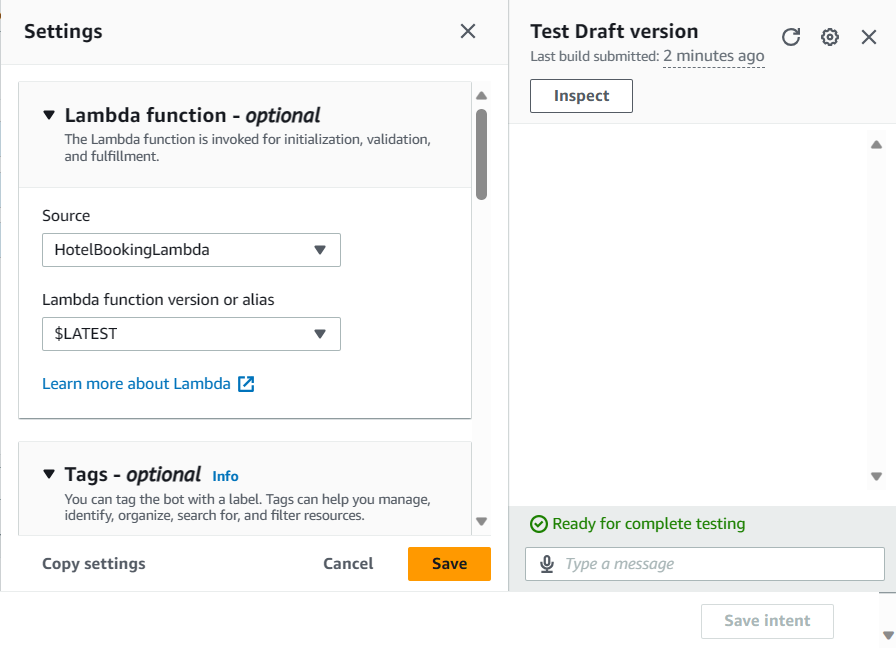

Lambda Code



Step 6: Testing and Iterating
Test the chatbot in the Amazon Lex console to ensure it understands and responds appropriately. Iterate on the design based on user interactions and feedback.
For test the chatbot Save Intent then Build and test.
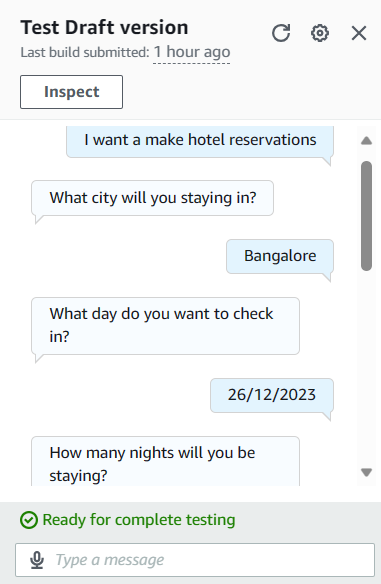
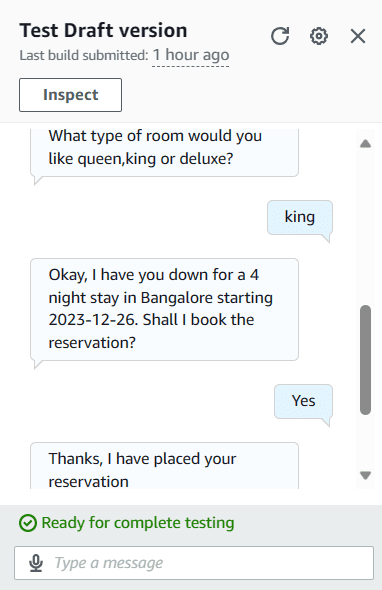
Question 1: What sets Amazon Lex apart from other conversational interface tools?
Answer:
Amazon Lex stands out due to its integration with AWS services, providing developers with seamless experience in building end-to-end conversational applications. The combination of Natural Language Processing (NLP) and Automatic Speech Recognition (ASR) allows Lex to understand and respond to both spoken and written language. Additionally, its flexible framework, integration with AWS Lambda for custom logic, and support for DynamoDB for structured data storage contribute to its power and versatility.
Question 2: How does Amazon Lex handle multi-turn conversations, and why is this important?
Answer:
Amazon Lex excels in managing multi-turn conversations, where interactions extend over several exchanges or turns. The system processes user input, responds, and continues the dialogue based on the context of the conversation. This capability is crucial for creating natural and engaging user experiences. By understanding context, Amazon Lex enables more meaningful interactions, making it ideal for applications such as customer support chatbots, appointment scheduling, and personalized shopping experiences.
Question 3: What are some practical applications of Amazon Lex, and how does it benefit different industries?
Answer:
Amazon Lex finds practical applications in various industries. For customer support chatbots, it streamlines query resolution and enhances customer satisfaction. In voice-activated interfaces, it provides hands-free interaction. E-commerce interfaces benefit from interactive product recommendations, creating personalized shopping experiences. Industries can leverage Lex for appointment scheduling, allowing users to interactively set appointments. The tool’s versatility, scalability, and seamless integration with the AWS ecosystem make it a valuable asset across sectors, from healthcare to retail.
Advantages
- Amazon Lex enables natural and conversational interactions, providing a more intuitive user experience.
- Scalability and Flexibility.
- Cost-Efficiency.
- Seamless integration with other AWS services simplifies the development of end-to-end conversational applications.
- Amazon Lex scales easily to accommodate varying workloads, ensuring consistent performance.
- Seamless Integration with AWS Ecosystem.
- Rapid Development and Deployment.
- Conversational interfaces can be deployed across various platforms, reaching a wider audience.
Disadvantages
- Developing sophisticated conversational interfaces may have a steep learning curve for beginners.
- Learning Curve for Advanced Features.
- Limited Customization in Lex’s Native Interface.
- Designing multi-turn conversations and managing user sessions can introduce complexity.
- Dependency on Internet Connectivity.
Limitations
- While powerful, the contextual understanding of Amazon Lex may have limitations in extremely nuanced contexts.
- The effectiveness of natural language processing may vary across languages.
- Handling Complex Dialogues.
- Lack of Deep Learning Capabilities.
Application
- Deploying Amazon Lex for customer support chatbots streamlines query resolution and enhances customer satisfaction.
- Voice-Activated Interfaces.
- E-commerce Conversational Interfaces.
- Leveraging Lex for interactive product recommendations, providing personalized shopping experiences.
- Customer Support Chatbots and Virtual Assistants.
- Implementing Lex for appointment scheduling, allowing users to interactively set appointments.
Amazon Lex serves as a robust tool for building conversational interfaces, offering a blend of natural interaction, integration flexibility, and scalability. While it empowers developers to create engaging applications, it’s essential to consider the learning curve and design complexities.
Applications span from customer support chatbots to interactive product recommendations, showcasing the versatility of Amazon Lex across industries. The limitations, such as context sensitivity and language support, should be weighed against the benefits to make informed development decisions.
Demystifying Amazon Lex unveils its potential to revolutionize user interactions, making it a valuable asset in the toolkit of developers creating next-generation conversational applications.








